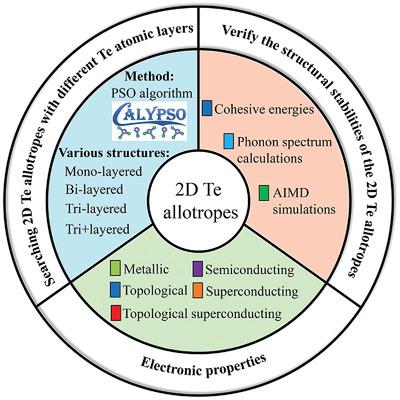当前位置:
X-MOL 学术
›
Adv. Theory Simul.
›
论文详情
Our official English website, www.x-mol.net, welcomes your feedback! (Note: you will need to create a separate account there.)
Structural, Topological, and Superconducting Properties of Two‐Dimensional Tellurium Allotropes from Ab Initio Predictions
Advanced Theory and Simulations ( IF 3.3 ) Pub Date : 2021-01-14 , DOI: 10.1002/adts.202000265 Chunxiang Zhao 1 , Xiaolin Cai 2 , Liangliang Liu 3 , Chengyan Liu 3 , Zaiping Zeng 3 , Chunyao Niu 1 , Congxin Xia 4 , Yu Jia 1
Advanced Theory and Simulations ( IF 3.3 ) Pub Date : 2021-01-14 , DOI: 10.1002/adts.202000265 Chunxiang Zhao 1 , Xiaolin Cai 2 , Liangliang Liu 3 , Chengyan Liu 3 , Zaiping Zeng 3 , Chunyao Niu 1 , Congxin Xia 4 , Yu Jia 1
Affiliation

|
The discovery of tellurene has effectively extended the realm of two‐dimensional (2D) elemental materials to group‐VI, which demonstrates promising potential in next‐generation electronic and optoelectronic device applications. Beyond the three prevailing structural phases of tellurene, it is further predicted 31 2D tellurium allotropes combining the particle‐swarm optimization (PSO) searches with density functional theory (DFT) calculations. The corresponding dynamic and thermal stability are examined by both phonon spectrum calculations and ab initio molecular dynamics (AIMD) simulations. Those 2D tellurium allotropes can be well categorized in terms of their intrinsic number of atomic layers, and cohesive energy. It is found that the allotropes with tri‐atomic layers are energetically most favorable, and mainly demonstrate semiconducting feature at larger cohesive energies. Four of the bi‐atomic‐layer allotropes with larger cohesive energies exhibit topological insulating feature, and two with slightly smaller cohesive energies are intrinsic superconductors with critical temperature Tc (≈8 K) competing with their bulk counterpart at high pressure. Interestingly, both topological and superconducting properties can co‐exist in one of those bi‐atomic‐layer allotropes, which is unique in the elemental 2D materials ever reported. The present study enriches the 2D tellurium allotropes and provides a viable platform for exploring novel functionalities for future device applications.
中文翻译:

从头算预测二维碲同素异形体的结构,拓扑和超导性质
碲的发现有效地将二维(2D)元素材料的领域扩展到了VI组,这证明了其在下一代电子和光电设备应用中的潜力。除了碲的三个主要结构相之外,结合粒子群优化(PSO)搜索与密度泛函理论(DFT)计算,可以进一步预测31个2D碲同素异形体。通过声子谱计算和从头算分子动力学(AIMD)模拟来检查相应的动态和热稳定性。这些2D碲同素异形体可以根据其固有的原子层数和内聚能进行很好的分类。发现具有三原子层的同素异形体在能量上最有利,并且主要表现出在较大内聚能下的半导体特性。具有较大内聚能的双原子同素异形体中的四个具有拓扑绝缘特性,而具有较小内聚能的二个同素异形体是固有的超导体,其临界温度Tc(≈8K)在高压下与其体相竞争。有趣的是,拓扑和超导特性可以共存于这些双原子层同素异形体之一中,这在有报道的元素二维材料中是独一无二的。本研究丰富了二维碲同素异形体,并提供了一个可行的平台,可用于探索未来设备应用的新颖功能。两种具有较小内聚能的是本征超导体,它们的临界温度Tc(≈8K)在高压下与它们的主体竞争。有趣的是,拓扑和超导特性可以共存于这些双原子同素异形体之一中,这在有报道的元素二维材料中是独一无二的。本研究丰富了二维碲同素异形体,并提供了一个可行的平台,可用于探索未来设备应用的新颖功能。两种具有较小内聚能的是本征超导体,它们的临界温度Tc(≈8K)在高压下与它们的主体竞争。有趣的是,拓扑和超导特性可以共存于这些双原子同素异形体之一中,这在有报道的元素二维材料中是独一无二的。本研究丰富了二维碲同素异形体,并提供了一个可行的平台,可用于探索未来设备应用的新颖功能。
更新日期:2021-02-04
中文翻译:

从头算预测二维碲同素异形体的结构,拓扑和超导性质
碲的发现有效地将二维(2D)元素材料的领域扩展到了VI组,这证明了其在下一代电子和光电设备应用中的潜力。除了碲的三个主要结构相之外,结合粒子群优化(PSO)搜索与密度泛函理论(DFT)计算,可以进一步预测31个2D碲同素异形体。通过声子谱计算和从头算分子动力学(AIMD)模拟来检查相应的动态和热稳定性。这些2D碲同素异形体可以根据其固有的原子层数和内聚能进行很好的分类。发现具有三原子层的同素异形体在能量上最有利,并且主要表现出在较大内聚能下的半导体特性。具有较大内聚能的双原子同素异形体中的四个具有拓扑绝缘特性,而具有较小内聚能的二个同素异形体是固有的超导体,其临界温度Tc(≈8K)在高压下与其体相竞争。有趣的是,拓扑和超导特性可以共存于这些双原子层同素异形体之一中,这在有报道的元素二维材料中是独一无二的。本研究丰富了二维碲同素异形体,并提供了一个可行的平台,可用于探索未来设备应用的新颖功能。两种具有较小内聚能的是本征超导体,它们的临界温度Tc(≈8K)在高压下与它们的主体竞争。有趣的是,拓扑和超导特性可以共存于这些双原子同素异形体之一中,这在有报道的元素二维材料中是独一无二的。本研究丰富了二维碲同素异形体,并提供了一个可行的平台,可用于探索未来设备应用的新颖功能。两种具有较小内聚能的是本征超导体,它们的临界温度Tc(≈8K)在高压下与它们的主体竞争。有趣的是,拓扑和超导特性可以共存于这些双原子同素异形体之一中,这在有报道的元素二维材料中是独一无二的。本研究丰富了二维碲同素异形体,并提供了一个可行的平台,可用于探索未来设备应用的新颖功能。



























 京公网安备 11010802027423号
京公网安备 11010802027423号